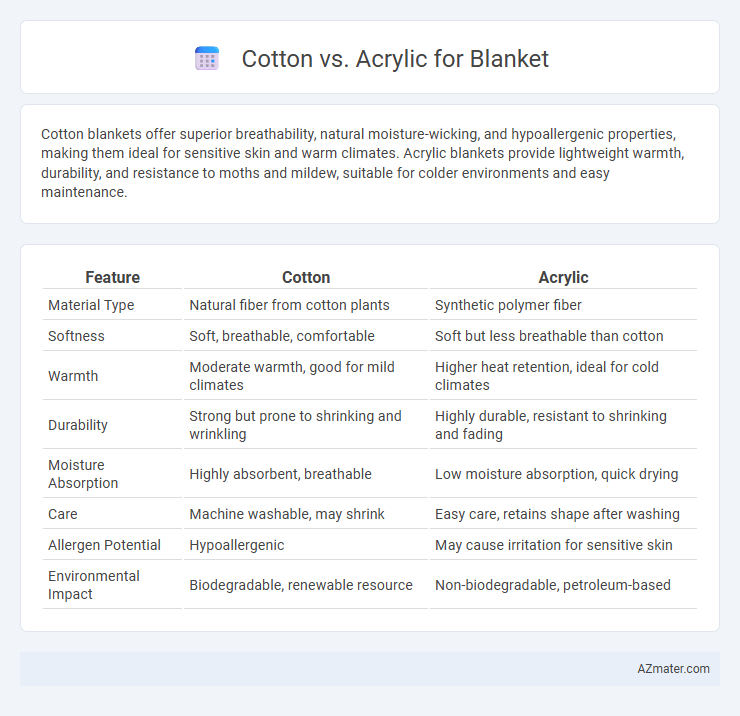Cotton blankets offer superior breathability, natural moisture-wicking, and hypoallergenic properties, making them ideal for sensitive skin and warm climates. Acrylic blankets provide lightweight warmth, durability, and resistance to moths and mildew, suitable for colder environments and easy maintenance.
Table of Comparison
| Feature | Cotton | Acrylic |
|---|---|---|
| Material Type | Natural fiber from cotton plants | Synthetic polymer fiber |
| Softness | Soft, breathable, comfortable | Soft but less breathable than cotton |
| Warmth | Moderate warmth, good for mild climates | Higher heat retention, ideal for cold climates |
| Durability | Strong but prone to shrinking and wrinkling | Highly durable, resistant to shrinking and fading |
| Moisture Absorption | Highly absorbent, breathable | Low moisture absorption, quick drying |
| Care | Machine washable, may shrink | Easy care, retains shape after washing |
| Allergen Potential | Hypoallergenic | May cause irritation for sensitive skin |
| Environmental Impact | Biodegradable, renewable resource | Non-biodegradable, petroleum-based |
Introduction to Blanket Materials
Cotton blankets offer natural breathability, moisture-wicking properties, and hypoallergenic benefits, making them ideal for sensitive skin and year-round comfort. Acrylic blankets provide affordability, lightweight warmth, and durability, often mimicking wool's texture while being resistant to moths and mildew. Choosing between cotton and acrylic depends on preferences for natural fibers versus synthetic advantages in maintenance and cost.
Overview of Cotton and Acrylic Fibers
Cotton fibers, derived from the natural cellulose of cotton plants, are renowned for their softness, breathability, and moisture-wicking properties, making cotton blankets highly comfortable and hypoallergenic. Acrylic fibers, synthetic polymers designed to mimic wool, offer durability, resistance to wrinkles and fading, and excellent insulation, resulting in warm and lightweight blankets. Choosing between cotton and acrylic depends on preferences for natural fiber benefits versus the easy-care and durability of synthetic materials.
Softness and Texture Comparison
Cotton blankets offer a natural softness and breathable texture, making them gentle on the skin and ideal for sensitive individuals. Acrylic blankets, while often softer initially, have a synthetic feel that can become less comfortable over time due to reduced breathability and potential pilling. The natural fibers in cotton provide a smooth, matte finish, whereas acrylic tends to have a shinier, less flexible texture.
Warmth and Insulation Properties
Cotton blankets offer natural breathability and moderate insulation, making them ideal for mild to cool climates but less effective in retaining heat during very cold conditions. Acrylic blankets provide superior warmth due to their synthetic fibers, which trap heat effectively and offer excellent insulation, closely mimicking wool's properties. For enhanced thermal retention and insulation, acrylic blankets outperform cotton, especially in environments requiring consistent warmth.
Breathability and Moisture Management
Cotton blankets excel in breathability due to their natural fibers, allowing air to circulate and helping to regulate body temperature effectively. Acrylic blankets, made from synthetic fibers, tend to trap heat and moisture, often resulting in reduced ventilation and less efficient moisture wicking. For optimal moisture management, cotton's absorbent properties make it ideal for keeping skin dry, whereas acrylic may retain sweat and humidity, impacting comfort during sleep.
Durability and Longevity
Cotton blankets offer superior durability due to their natural fiber structure, allowing them to withstand frequent washing and maintain softness over time. Acrylic blankets, while resistant to moisture and mildew, tend to pill and degrade faster with regular use. Choosing cotton ensures a longer-lasting blanket that remains comfortable and retains its quality through years of use.
Allergies and Skin Sensitivity
Cotton blankets are hypoallergenic and naturally breathable, making them ideal for individuals with sensitive skin or allergies by reducing irritation and preventing overheating. Acrylic blankets, while soft and warm, can sometimes cause skin irritation or allergic reactions due to synthetic fibers and chemical treatments. Choosing cotton helps minimize the risk of allergic responses and promotes better skin health for those prone to sensitivity.
Care, Maintenance, and Washing
Cotton blankets require gentle washing with mild detergent and are best air-dried to maintain softness and prevent shrinkage, while acrylic blankets are machine-washable and quick-drying, making them more resistant to wrinkles and easier to maintain. Cotton fibers are prone to fading and pilling if washed in hot water or dried on high heat, whereas acrylic resists discoloration and holds color longer even after multiple washes. Proper care for cotton involves avoiding bleach and high temperatures, whereas acrylic tolerates more robust cleaning but should still be dried flat or on low heat to preserve fiber integrity.
Environmental Impact and Sustainability
Cotton blankets, especially organic cotton, have a lower environmental impact due to their biodegradability and natural renewable resource base, though conventional cotton farming often requires high water usage and pesticides. Acrylic blankets, derived from petroleum-based synthetic fibers, contribute to microplastic pollution and non-biodegradable waste, making them less sustainable options. Choosing blankets made from sustainably sourced cotton reduces carbon footprint and supports soil health, whereas acrylic production relies on fossil fuels and increases ecological harm.
Price and Value for Money
Cotton blankets generally cost more upfront but offer superior breathability, durability, and eco-friendliness, providing long-term value despite a higher initial price. Acrylic blankets are typically cheaper and lightweight, making them a budget-friendly option, though they may lack the softness and longevity of cotton. Choosing between the two depends on prioritizing cost savings or quality and durability for overall value.

Infographic: Cotton vs Acrylic for Blanket
 azmater.com
azmater.com